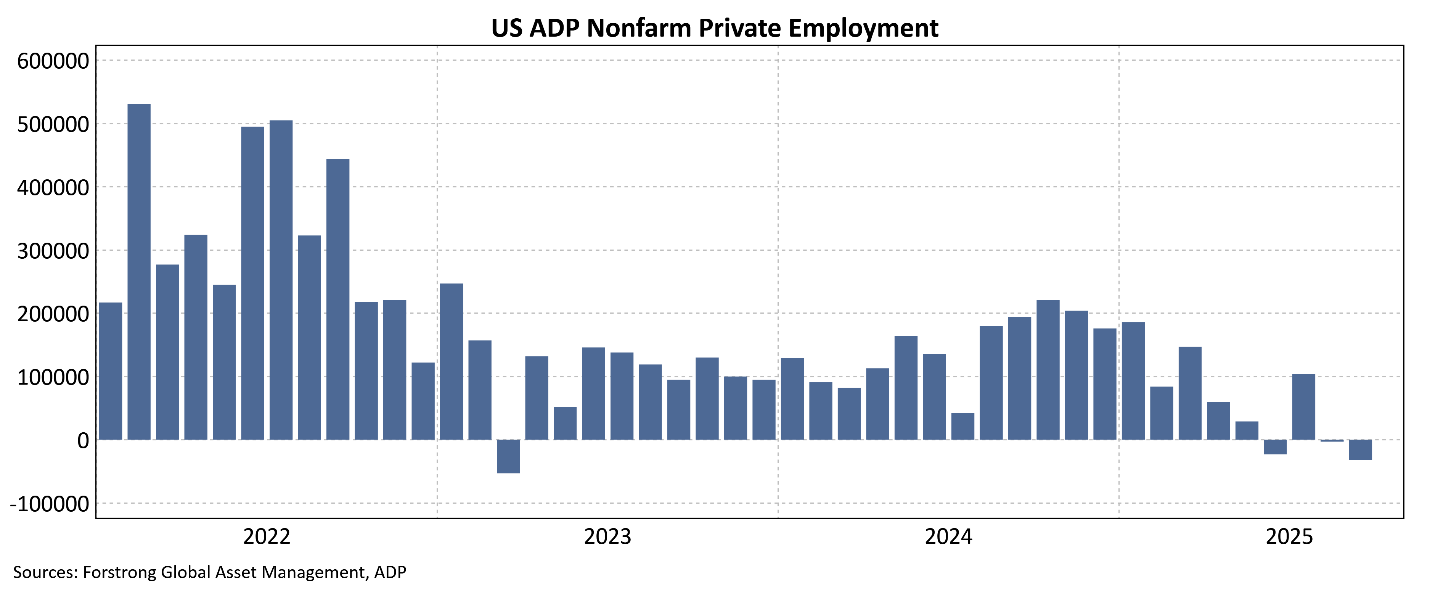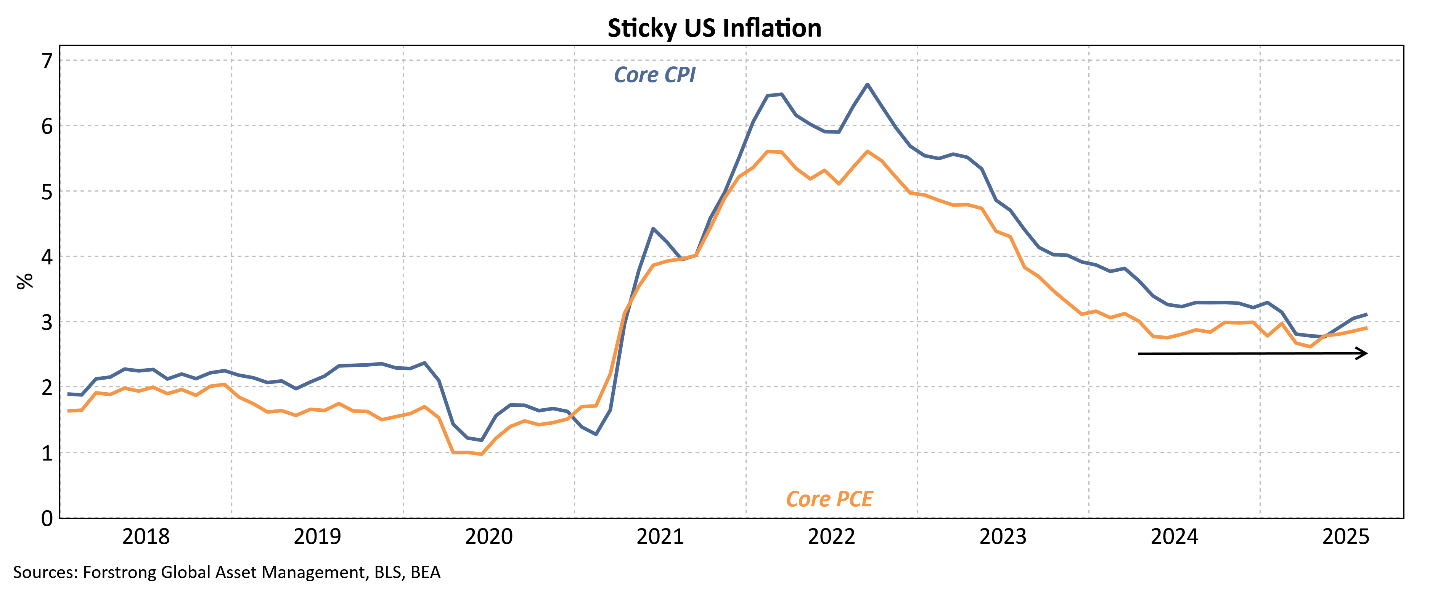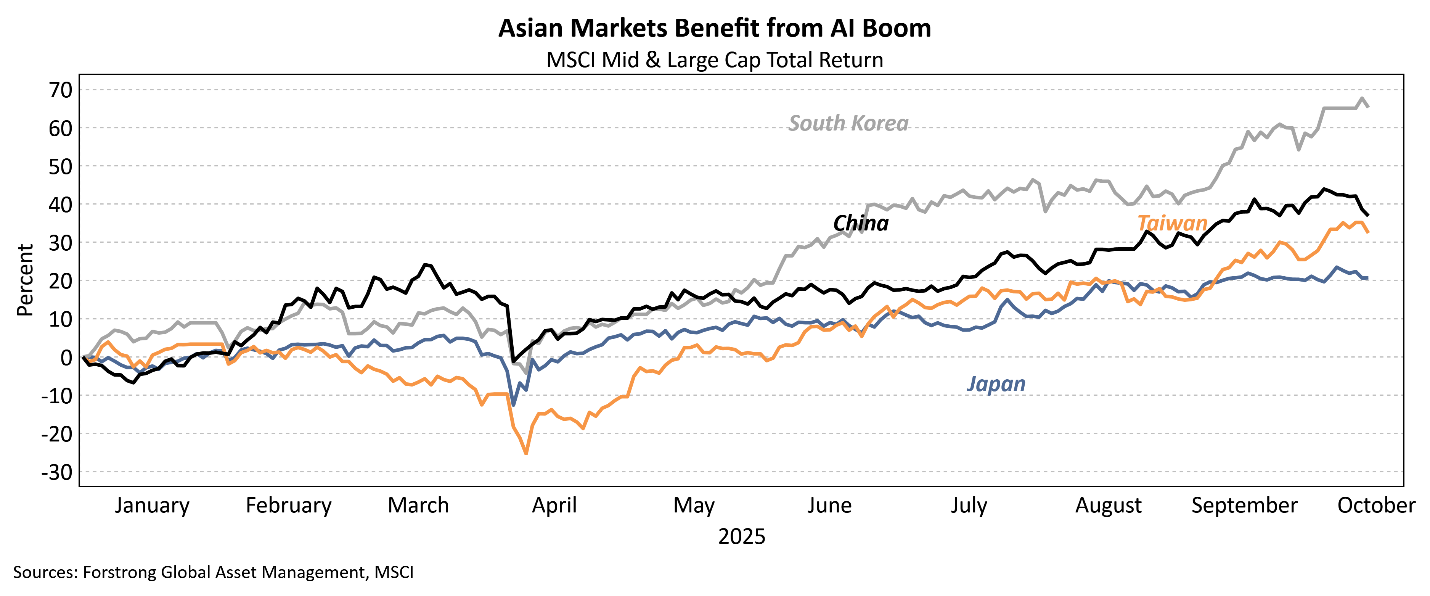Ask Forstrong
Is The Winning Streak Over?
October 2025
Ask Forstrong: Markets stumbled last week. What could short-circuit the current bull market?
Key Takeaways
- A correction in today’s environment shouldn’t come as a shock. Sentiment is stretched and equity markets have just enjoyed a remarkable run—the MSCI World Index is up roughly 40% over the past six months.
- Keep an eye on the risks: US recession, accelerating inflation, and a potential AI stumble could trip up the bull.
- But the global bull market is not over, fueled by supportive policymakers, rising corporate earnings, and accelerating growth in international markets.
One of Donald Trump’s more headline-grabbing lines back in 2016 was his punchy promise that “we’re gonna win so much, you may even get tired of winning. And you’ll say, ‘please, please it’s too much winning. We can’t take it anymore.’”
Putting aside the President’s eccentricities for a moment, he had some foresight, didn’t he? 2025 has been a year of winning. America’s four major equity indexes recently hit record highs in a rare, synchronized rally. And the multi-trillion-dollar boom in US stocks from April’s lows has spilled over into other global markets. China’s stock markets, long dismissed as “uninvestable”, have staged a remarkable comeback. Gold prices have had their best start to the year since 1979. Even Toronto Blue Jays fans, after more than three decades of heartbreak, are now witnessing a postseason run that could finally carry their team to the World Series. So much winning—exhausting, isn’t it?
Heading into 2025, our investment team’s central macro thesis was simple: the bull market that started in America would broaden to other asset classes and geographies. Trump’s tariff war, far from being a purely negative shock, would trigger reactionary waves of domestic stimulus abroad, igniting powerful rallies in those markets—what we call the “Protectionist Paradox”. Nailed it.
But we’ve blown out too many birthday candles to ever declare victory in the investment business. Our job is not just to grow client portfolios but, even more importantly, to protect them. Last week reminded us how fast euphoria can turn into panic. Renewed tariff threats sent a shockwave through markets. Crypto suffered its largest single-day wipeout ever. Nearly everything else dropped sharply too.
Where do we go from there? Sentiment is stretched and the conditions for a correction, whether one happens or not, are here. Wall Street has become ultra bullish, institutional equity allocations are at elevated levels and the hype around AI has become even wilder. And while September has a hasty reputation for market declines, the biggest ones have all occurred in October—1929, 1973, 1987 and 2008.
All of which brings us to today’s burning question: what could derail the current global bull market and create a deeper downturn? Where are the blind spots that investors are underestimating?
Risk 1. US Recession
The first and most obvious risk is a US recession. The biggest bear markets rarely show up solo—they arrived hand-in-hand with recessions. But what could spark one? While Trump’s tariff threats against China continue, the overall trend since April has been gradual de-escalation. Still, US global tariffs are now baked in, with the average rate at 17.5%, the loftiest level since 1935. Economics 101 say tariffs create deadweight loss and slow global growth. Yet markets seem happy to look the other way. Are investors being too complacent?
Right now, the American economy feels like two parallel universes: a rip-roaring AI sector and a sluggish consumer one. Last quarter, AI-related capital expenditures alone contributed 1.1% to US GDP growth, outpacing the consumer as an engine of expansion. But households still need to carry their weight. Recent data isn’t pretty: fast-food chains and specialty retailers have disappointed, Vegas traffic has cooled, and lower-income consumers—already squeezed by rising costs (thanks in part to tariffs)—are tightening belts.
With the Bureau of Labor Statistics temporarily closed, private data is our best real-time window into the labour market. ADP estimates suggest private payrolls contracted by 32,000 in September. Watch this signal: if downside employment momentum worsens, avoiding a recession could become very tricky. For now, though, “low hiring, low firing” remains the order of the day—an uneasy equilibrium that keeps the economy grinding forward.

Risk 2. Higher Inflation
The second major risk is an acceleration in inflation. Historically, central bank rate hiking cycles to combat rising prices are the prime culprit behind recessions—higher bond yields can turn a healthy economy into a stumbling one fast. Yet the recent rallies in global government bonds, combined with market bets that the Fed will cut rates from today’s 4.25% to 3% by December 2026, show markets now believe inflation is yesterday’s problem. Reality check? US inflation has stubbornly hovered around 3% for nearly two years, with little sign of a meaningful downtrend.

The American policy backdrop isn’t helping. Trade barriers, restricted immigration, and massive deficits in an economy still near full employment are all putting pressure on prices. If the US manages to avoid a recession, this could entrench inflation even further, making the market’s “inflation solved” narrative look wildly over-optimistic. Monitoring inflation trends will be key here. Any significant pickup from the current trend could trip up the bull market.
Risk 3: AI Stumble
The last major risk is all about AI. Never before has so much money been poured so lavishly into a technology that, for all its promise, remains largely unproven as a profit engine. A few weeks ago, Nvidia agreed to invest as much as $100 billion in OpenAI to fund a data-center buildout massive enough to power a major city. OpenAI, in turn, committed to filling those sites with millions of Nvidia chips. The day after, OpenAI revealed a separate $300 billion deal with Oracle to build more data centers—Oracle, naturally, is also buying billions of dollars worth of Nvidia chips for the project. Got all that?
If your head is spinning, you’re not alone. And if you were there for the tech melt-up of the late 1990s, you’re likely feeling déjà vu. Back then, circular deals often centered on advertising and cross-selling between startups. But the principle was the same: fresh investment in one company would instantly appear as revenue for another, increasingly binding the fates of multiple firms together.
Since ChatGPT launched in November 2022, 41 AI-related stocks have driven some 75% of the S&P 500’s gains. The catch? Profits from actual AI usage—rather than infrastructure spending—haven’t kept up with the pace yet. OpenAI doesn’t expect to be cash-flow positive until the end of the decade. Even the tech giants are leaning on older business lines for their largest margins while AI investments drain corporate cash.
If these massive infrastructure bets fail to generate end-user profits, today’s AI surge could turn out less like a generational trade and more like a historic bubble. Monitoring whether all this capex translates into real profits will be key—and could determine whether the AI story fuels the bull market or derails it.
What Could Go Right?
To be clear, none of these risks are yet our base case. While recession worries have ticked up, global growth continues to grind higher. Often lost in the headlines is that the world’s two largest engines of growth outside the US—China and Europe— are only now emerging from their post-Covid slumps. Europe is now in a solid cyclical recovery. China, after years of regulatory crackdowns and a deflating property sector, has turned a major corner.
Governments, meanwhile, are spending like there’s no tomorrow. Massive fiscal deficits always translate into massive corporate profits (sorry, I don’t make the equations). On the monetary side, roughly 85% of global central banks are cutting rates, seemingly content with 2% inflation as a floor rather than the ceiling it was in the 2010s. In short, policymakers have given the green light for risk-taking.
And AI? The spending spree is going global. Sam Altman’s recent “shopping trip” in Asia sparked deals in Taiwan (GPUs), South Korea (memory chips), and Japan (power transmission equipment). The ripple effects from this AI capex boom—jobs, production, and technological growth—are now being felt far beyond the US. For now, the AI game is still very much on.
Taken together, the picture that’s emerging is one of a global expansion finally broadening out. The “Big, Beautiful Bull Market” no longer belongs solely to America—it’s becoming a truly international affair.

Investment Implications
A correction in today’s environment shouldn’t come as a shock. Global equities have just delivered a remarkable run—the MSCI World Index is up roughly 40% over the past six months. A short-term pullback on bad news is more digestion than derailment.
But, as always, investors need to balance risks and opportunities rather than running for the hills or going all-in on risk. Binary moves rarely end well.
Today, the setup is clear: trim some exposure to the crowded corners of the AI trade and lean into markets with better value and rising momentum. The bull market in precious metals is broadening into other commodities. China’s accelerating equity rebound is reigniting animal spirits across emerging markets. Even small-caps—long dismissed as “dead money”—are showing signs of life.
Looking ahead, keep an eye on the above macro risks. But for now, this is still a world with more winning left to do.

The information contained in these materials is for general informational purposes only and is intended to provide only brief comments on broad market, industry or sector trends, or other general economic or market conditions. It is not intended to provide an overview of the terms applicable to any products or funds managed or sponsored by Forstrong Global Asset Management Inc. (“Forstrong”). Views expressed regarding a particular company, security, industry, investment, or market sector are the views only of that individual as of the time expressed and do not necessarily represent the views of Forstrong or any other person in the Forstrong organization. These materials contain information and views as of the date indicated and such information and views are subject to change at any time without notice, based upon market and other conditions, and Forstrong disclaims any and all responsibility to update such information and views. These views are not and may not be relied upon as investment advice and, because investment decisions for a Forstrong fund or product are based on numerous factors, are not and should not be relied upon as an indication of trading intent on behalf of any Forstrong fund or product. Any opinion or assumption may contain elements of subjective judgment and are not intended to imply, nor should be interpreted as conveying, any form of guarantee or assurance by Forstrong of any future action or performance. Neither Forstrong nor any of its affiliates, businesses, or representatives make any representation or warranty, express or implied, as to the accuracy, reliability, completeness, appropriateness, or sufficiency for any purpose of any information contained herein. Forstrong and its affiliates and related entities disclaim any and all liability relating to the information herein, including, without limitation, any express or implied representations or warranties for, statements contained in, and omissions from, the information. Forstrong and its affiliates and related entities are not liable for any errors or omissions in any information herein or for any loss or damage suffered, whether direct or consequential, resulting from the use of these materials.
The information contained in these materials is strictly for general illustrative, educational, or informational purposes, and is not intended to provide legal, investment, accounting, or tax advice, and should not be relied upon in that regard. These materials contain information and views as of the date indicated and such information and views are subject to change at any time without notice, based upon market and other conditions, and Forstrong disclaims any and all responsibility to update such information and views. These views are not and may not be relied upon as investment advice. Any opinion or assumption may contain elements of subjective judgment and are not intended to imply, nor should be interpreted as conveying, any form of guarantee or assurance by Forstrong of any future action or performance. Neither Forstrong nor any of its affiliates, businesses, or representatives make any representation or warranty, express or implied, as to the accuracy, reliability, completeness, appropriateness, or sufficiency for any purpose of any information contained herein. Forstrong and its affiliates and related entities disclaim any and all liability relating to the information herein, including, without limitation, any express or implied representations or warranties for, statements contained in, and omissions from, the information. Forstrong and its affiliates and related entities are not liable for any errors or omissions in any information herein or for any loss or damage suffered, whether direct or consequential, resulting from the use of these materials.
Any specific companies, issuers, funds, ETFs, or indices mentioned are for illustrative or educational purposes only and are not and shall not be deemed to be a recommendation to buy or sell any securities. Any companies, issuers, funds, or ETFs mentioned do not necessarily represent current or future holdings of any Forstrong funds or products. Any strategies discussed are strictly for illustrative and educational purposes and are not a recommendation, offer, or solicitation to buy or sell any securities or to adopt any investment strategy. There is no guarantee that any strategies discussed will be effective.
Commissions, fees, and expenses may be associated with investments in Forstrong funds, ETFs, and/or other investment products. Please read a fund’s offering memorandum or ETF’s prospectus, as applicable, which contains detailed information, and speak to an advisor before investing. Funds and ETFs are not guaranteed, their values change frequently, and investors may experience a gain or loss. Past performance may not be repeated.
Certain statements in these materials may contain forward-looking statements or forward-looking information that are predictive in nature and may include words such as “expects”, “anticipates”, “intends”, “plans”, believes”, “estimates”, and similar forward-looking expressions or negative versions thereof. Such forward-looking statements are based on current expectations and projections about future general economic, political, and other relevant market factors, such as interest, and assuming no changes to applicable tax or other laws or regulations. Expectations and projections about future events are inherently subject to, among other things, risks and uncertainties, some of which may be unforeseeable and, accordingly, may prove to be incorrect at a future date. Forward-looking statements are not guarantees of future performance, and actual events could differ materially from those expressed or implied in any forward-looking statements. A number of important factors can contribute to these differences, including, but not limited to, general economic, political, and market factors in Canada and internationally, interest and foreign exchange rates, global equity and capital markets, business competition, and catastrophic events. You should avoid placing any undue reliance on forward-looking statements. Past performance is no indicator of future performance and the materials are not intended to forecast or predict future events. Forstrong disclaims any and all responsibility to update any forward-looking statements, whether as a result of new information, future events, or otherwise, except as specifically required by law.
The information contained herein is presented solely for illustrative purposes and should not be construed as a forecast or projection. While some information used herein has been obtained from various published and unpublished third-party sources considered to be reliable, such information has not been independently verified by Forstrong (and Forstrong disclaims any obligation to verify) and Forstrong does not guarantee its accuracy or completeness and accepts no liability for any loss or damage suffered, whether direct or consequential, resulting from its use. It should be noted that data provided may be approximate numbers.
Forstrong Global® and the Forstrong Global® logo are trademarks or registered trademarks of Forstrong Global Asset Management Inc. in Canada.
© 2025 Forstrong Global Asset Management Inc. All rights reserved.